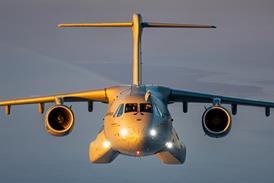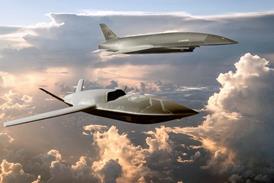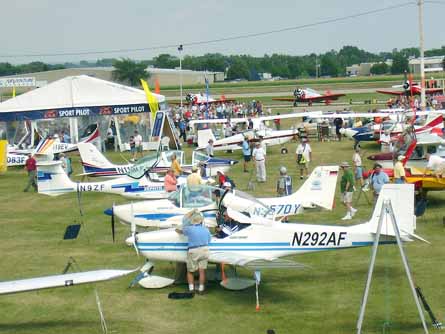Defining the rules for light-sport aircraft is a big test for Europe's fledgling safety agency EASA. Can it cut through political red tape?
The future of light aircraft in Europe includes relaxed regulations and possibly the same industry standards that have cut the manufacturing costs of aircraft flown in the USA and Australia. What will be included in the new European Light Aircraft regulation is being hammered out, and its implementation will be a large step for the young European Aviation Safety Agency.
Almost anyone who can drive a car can be a light-sport pilot in the USA, and manufacturers and pilot groups are hoping that similar leniency in Europe could revive its ailing general aviation market. There are four GA aircraft in the USA for every one in Europe, although two-thirds of the light-sport aircraft (LSA) flown in the USA are made in European Union nations.
|
|---|
New European light sport rules could lead to Oshkosh-like gatherings on the continent |
"Unfortunately, even though we produce most of them, we cannot fly these planes in Europe because this category does not exist," says Jan Fridrich, vice-president for foreign affairs, industry and internal audit for the Light Aircraft Association of the Czech Republic. "For manufacturers it will be better, because they will not need to split their attention between the European and American markets. The planes will be the same."
Market values
The US market consumed 400 factory-built LSAs last year, valued at about $38 million. More than 600 are expected to be delivered in 2007, worth about $60 million. That does not include used aircraft bought by new pilots content to fly only during daytime and with only one passenger.
The radical shift in Europe will not be the pilot regulations as much as the reliance on industry-developed standards. Graham Newby, chief executive of the Popular Flying Association, says: "The microlight aircraft in Europe are in many cases more sophisticated, fly faster, and so on, than LSA aircraft, so to just bring LSA to Europe will be a backward step."
Working group
Just as the LSA rule was developed co-operatively by the Federal Aviation Administration with US pilots and manufacturers groups, the new European regulations are being shaped by the MDM.032 working group under the guidance of EASA. Newby and Fridrich are both members, and often hear from Earl Lawrence, vice-president of government relations for the Oshkosh-based Experimental Aircraft Association, who helped create LSA and chairs standards-developer ASTM's F37 light-sport aircraft committee.
Lawrence says he does not hear concerns over the safety of industry standards, but does often clarify the role of ASTM. "The standards set forth the strength requirements of the aircraft - the design considerations. But they don't set weight and speed limits. This is a common misconception," he says.
The size and type of aircraft that will fit within the new rule is not decided, although MDM.032's members face the deadline of September 2008, when EASA's full set of rules go into effect. The working group has set September 2007 as the target for draft regulatory requirements for the recreational private-pilot licence and general operating rules established as extensions of the basic regulations. March was to be the date for release of an opinion on amending airworthiness implementation rules, but the group was delayed by the unprecedented 7,000 public comments received by October.
As it prepares responses, MDM.032 continues searching for a means to include what some are calling the European Light Aircraft (ELA) category within the primary European airworthiness and maintenance regulation, called 1592/2002. If it will not fit and a new regulation is needed, Newby says, "we are looking at four or five years and having to go through the whole political as well as the governmental consultation process, which is something we don't want to do if we can help it".
New category
Fridrich has a different view. A document released by a December meeting of manufacturers organised by Fridrich, which makes numerous proposals and coins the term ELA, refers to the time wasted by the USA and Australia before they gave up on simplifying existing regulations to create new ones. "To avoid this we propose not to make experiments and create this new category as quickly as possible," it says.
The many unknowns led the chairman of the MDM.032 working group to decline to comment for this article until after the next meeting at the Aero Expo in Friedrichshafen.
Official documents from the working group are limited. Minutes are not released, but the advance notice of proposed amendment (A-NPA) suggests operating rules should have a level of detail comparable to International Civil Aviation Organisation Annex 6 Part II. Adjusting the current private-pilot licence standards could bring unwanted complications, and a new type of licence is being considered. The A-NPA says there should be no arbitrary restrictions on airspace and airports built into the rule, and the issuing of medical certificates could be based on an general practitioner's assessment following a self-declaration signed by the pilot.
Consensus seems to have been reached that adjustable propellers and retractable landing gear should be allowed, which Australia permits but the USA does not. Consensus on other issues is has not been reached. The group is talking about an EASA Part 21 "light" regulation for airworthiness certification, in addition to Parts 66 and M "light" governing maintenance, but as one member says: "Nobody can say how light it will be."
"If maintenance will go under Part M, then it's over," says Fridrich. "It's not necessary to create any new category because it will be killed from the very beginning." The same goes for Part 21, he believes, speaking as a former service manager for manufacturer Evektor-Aerotechnik who left to promote ELA.
It should be a complete package, he says: "Airworthiness is just one part." The other important parts to create balance are licensing, operations and maintenance. "The boom of the microlights was caused by the self-regulation organisations and by the simple rules. I think after 15 or 17 years of working on this category in many countries, the experience is quite good and we have something we can build on, so the move to an LSA category is a logical step," he says, adding: "The easiest solution would be to increase the maximum take-off mass [MTOM] to 600kg [1,320lb] and all of these things will be taken care of."
But support is growing for a maximum take-off weight of 890kg, which Newby welcomes. "That's certainly EASA's wish that we try and encompass as many of the sporting aviation bodies within this as possible - the gliders, for instance: competition gliding has a take-off maximum of 850kg," he says. "It could, perhaps, apply to heavier and faster, more complex aircraft than it has applied to in America."
Risk assessment
According to European Air Sports (EAS) secretary-general Harry Schoevers, the discussion of MTOM "is very much based on the assessment of risk to uninvolved third parties, for which it is generally accepted by the regulators that up to 2,000kg MTOM is 'not a problem' - hence the proposed new leisure PPL up to 2,000kg MTOM. So within that general 'light aircraft' range, 890kg is no big deal." Seven of the 16 working-group members represent EAS, the association co-ordinating European regulatory matters for national aero clubs, associations and European air-sports unions.
Fridrich and MDM.032 member Jo Konrad (representing the International Aircraft Owners and Pilots Association) oppose the upward shift. "Suddenly we were forced into a new discussion about a subcategory for touring motor gliders," says Konrad. "Nobody knows how we will implement this category in our future recreational class, which was defined originally as up to 2t [and in the very beginning up to 5.7t]."
Members acknowledge that politics are playing a role and the final proposal may face a political gauntlet before approval. Schoevers says: "EAS is building up a 'lobby' force to ensure proper legislation proportional to the need and position in the EU society of our sector of aviation."
EASA's Daniel Holtgen explains who will have final input. "The Commission decides in consultation with the member states. The Parliament, in this case, is not involved."
Konrad, who chairs the German ultralight association DULV, is concerned that "the work of the European government bodies is not very co-ordinated. For example, we talked about the possibility that EASA can delegate some work to the proposed 'assessment bodies' as noted in the A-NPA, and the council of ministers disapproved of this. But in its decision, the council of ministers laid down that the Annex II of this basic regulation shouldn't be touched."
UK Member of European Parliament Brian Simpson sees support overall for an expanded EASA. " There may be some issues over EASA, making sure they don't run before they walk, but I think parliament would be supportive of things like the extension of EASA."
Source: Flight International













































